High Impact Tutoring Built By Math Experts
Personalized standards-aligned one-on-one math tutoring for schools and districts
In order to access this I need to be confident with:
2D shapes Triangles Parallelograms Types of angles Right angles Parallel linesInterior and exterior angles of polygons
Here you will learn about interior and exterior angles of polygons, including what interior and exterior angles of polygons are, and how to calculate angles in polygons using a variety of methods.
Students will first learn about interior and exterior angles of polygons as a part of geometry in high school.
What are the interior and exterior angles of polygons?
Interior and exterior angles of polygons are two types of angles found in polygons. At any given vertex of a polygon, the interior and exterior angles are supplementary, meaning that they add together to equal 180^{\circ}.
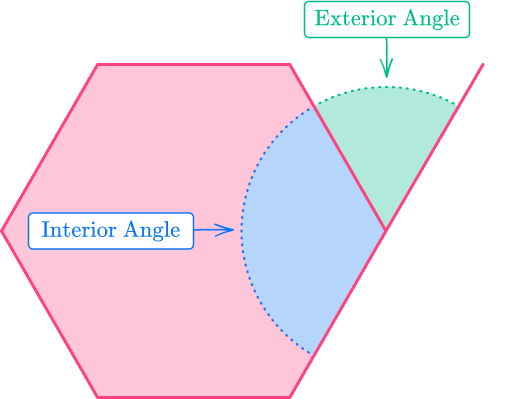
A polygon is a two dimensional shape with at least three sides, where the sides of a polygon are all straight lines. ‘Poly’ comes from the Greek for ‘many’ and ‘gon’ means ‘angles’. You should be familiar with many types of polygons such as triangles, rectangles, pentagons, and heptagons.
A polygon where all angles are equal size and all sides are equal length is called a regular polygon.
A polygon where all angles are not equal size and/or all sides of the polygon are not equal length is called an irregular polygon.
![[FREE] Angles Check for Understanding Quiz (Grade 4)](https://thirdspacelearning.com/wp-content/uploads/2023/08/Angles-check-for-understanding-quiz-listing-image.png)
[FREE] Angles Check for Understanding Quiz (Grade 4)
![[FREE] Angles Check for Understanding Quiz (Grade 4)](https://thirdspacelearning.com/wp-content/uploads/2023/08/Angles-check-for-understanding-quiz-listing-image.png)
Use this quiz to check your grade 4 students’ understanding of identifying and measuring angles. 10+ questions with answers covering a range of 4th grade angles topics to identify areas of strength and support!
DOWNLOAD FREE![[FREE] Angles Check for Understanding Quiz (Grade 4)](https://thirdspacelearning.com/wp-content/uploads/2023/08/Angles-check-for-understanding-quiz-listing-image.png)
[FREE] Angles Check for Understanding Quiz (Grade 4)
![[FREE] Angles Check for Understanding Quiz (Grade 4)](https://thirdspacelearning.com/wp-content/uploads/2023/08/Angles-check-for-understanding-quiz-listing-image.png)
Use this quiz to check your grade 4 students’ understanding of identifying and measuring angles. 10+ questions with answers covering a range of 4th grade angles topics to identify areas of strength and support!
DOWNLOAD FREEInterior angles of a polygon
Interior angles are the angles within a polygon made by two adjacent sides.
You can calculate the sum of the interior angles of a polygon by subtracting 2 from the number of sides and then multiplying by 180^{\circ}.
The sum of interior angles of a regular polygon means finding the total of all the angles inside a polygon. The sum of all the angles in a triangle is equal to 180^{\circ}, but what about angles in a quadrilateral? A regular pentagon? Or even an irregular octagon?.
Step by step guide: Interior angles of a polygon
Sum of the angles in a triangle
The three angles in any triangle add up to 180^{\circ}, or “The sum of interior angles for a triangle is 180 degrees”.
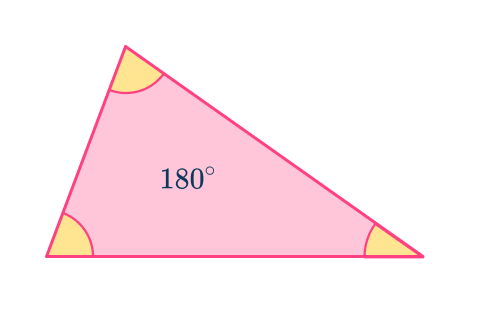
Step by step guide: Angles of a triangle
Sum of the angles in a quadrilateral
A quadrilateral is a four sided shape. A quadrilateral can be split into two triangles by drawing a line from one corner to an opposite one.

If the sum of interior angles of one triangle is 180^{\circ}, then the sum of the interior angles of two triangles is 180^{\circ}\times{2}=360^{\circ}
The sum of the interior angles of a quadrilateral is 360^{\circ}.

Step by step guide: Quadrilateral angles
Using the knowledge of triangles, you can find the sum of the interior angles of any polygon by splitting it into a number of triangles.
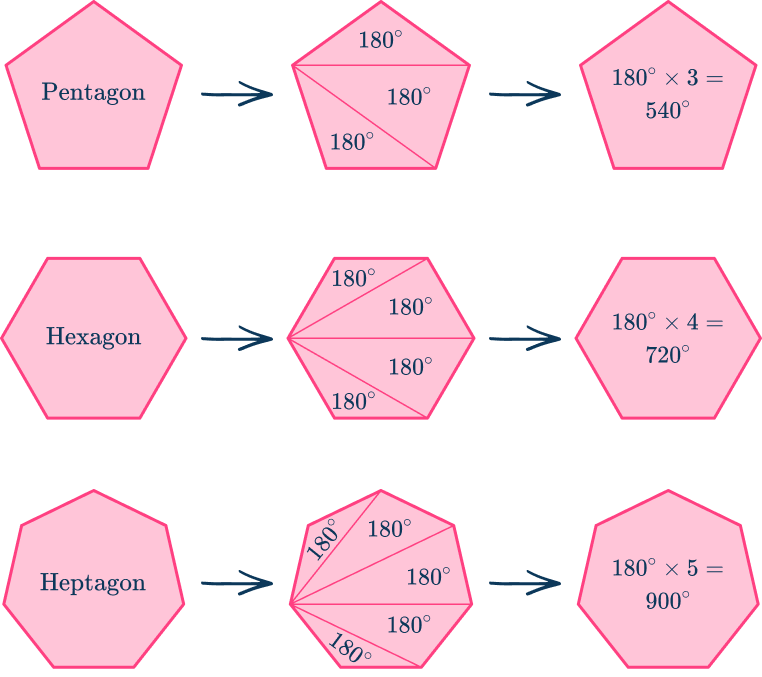
The interior angles of a polygon can also be found using the formula:
Sum of interior angles =(n-2)\times{180}
For example, a regular hexagon has 6 sides so n=6. You can substitute n=6 into the formula.
Sum of interior angles =(6-2)\times{180}=4\times{180}=720^{\circ}
The sum of the interior angles of a hexagon is 720^{\circ}.
Step by step guide: Angles of a hexagon
For any regular polygon:
\text{Each interior angle}=\cfrac{\text{Sum of interior angles}}{\text{Number of sides}}
Continuing with the regular hexagon above,
\text{Each interior angle}=\cfrac{\text{Sum of interior angles}}{\text{Number of sides}}=\cfrac{720}{6}=120^{\circ}
Each interior angle of a regular hexagon is 120^{\circ}.
Exterior angles of a polygon
Exterior angles are the angles between a polygon and the extended line from the next side.
The sum of the exterior angles of a regular polygon is always 360^{\circ} regardless of the number of sides the polygon has.
The exterior angles are angles between a polygon and the extended line from the vertex (center) of the polygon.
Sum of Exterior Angles of a Polygon =360^{\circ}
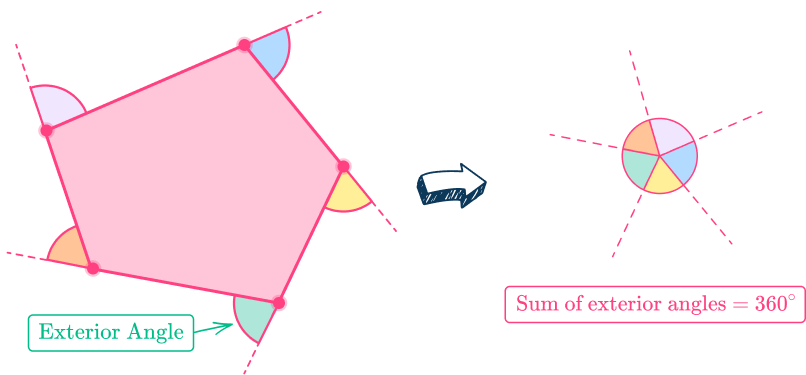
The interior angle and exterior angle at a vertex form a straight line, which adds to 180^{\circ}.
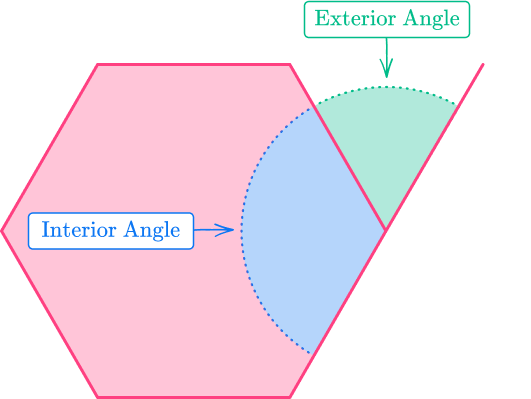
For a regular polygon, every exterior angle is the same and is calculated using the formula:
E=\cfrac{360}{n}where E represents one exterior angle and n is the number of sides of the regular polygon.
Step by step guide: Sum of exterior angles of a polygon
What are the interior and exterior angles of polygons?
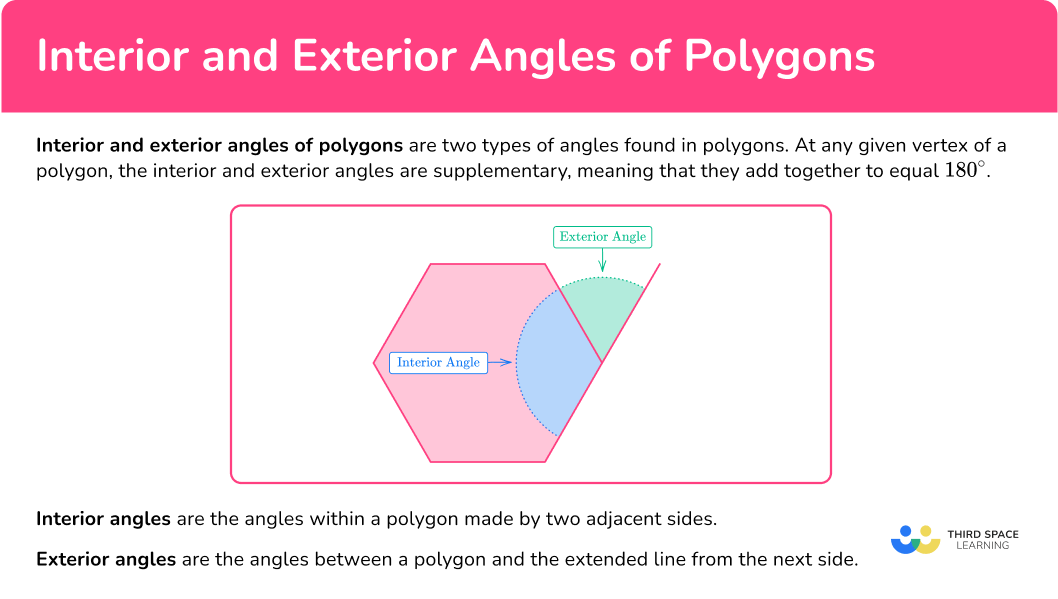
What is interior angles of a polygon?
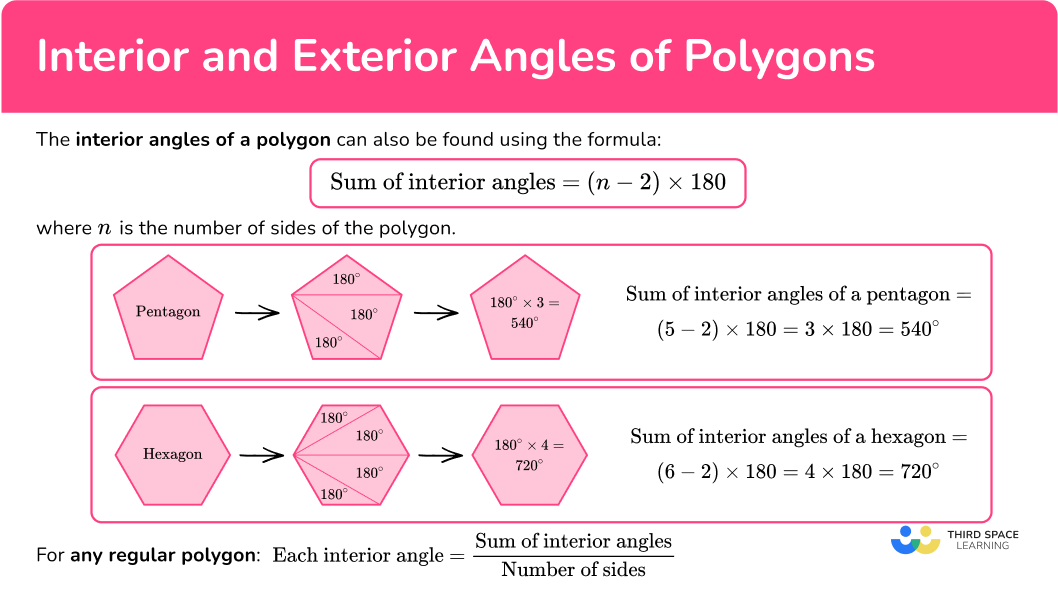
What is exterior angles of a polygon?
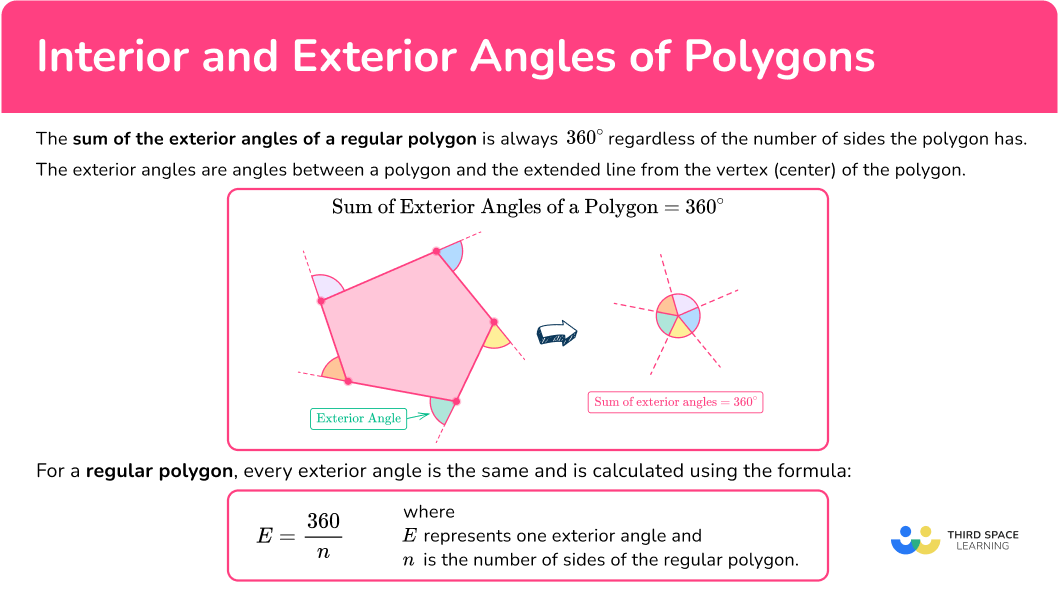
Common Core State Standards
How does this relate to high school math?
- High School: Geometry (HS.G.CO.C.10)
Prove theorems about triangles. Theorems include: measures of interior angles of a triangle sum to 180^{\circ}; base angles of isosceles triangles are congruent; the segment joining midpoints of two sides of a triangle is parallel to the third side and half the length; the medians of a triangle meet at a point.
- High School: Geometry (HS.G.CO.C.11)
Prove theorems about parallelograms. Theorems include: opposite sides are congruent, opposite angles are congruent, the diagonals of a parallelogram bisect each other, and conversely, rectangles are parallelograms with congruent diagonals.
How to find interior angles of polygons:
- Identify the number of sides and whether any polygons are regular/irregular.
- Find the sum of interior angles of the polygon(s).
- Solve the problem using the information gathered.
Interior and exterior angles of polygons examples
Example 1: interior angles – irregular quadrilateral
Find the sum of interior angles for this polygon.

- Identify the number of sides and whether any polygons are regular/irregular.
This polygon has four sides.
This polygon is irregular as all the sides are not of equal length.
2Find the sum of interior angles of the polygon(s).
Sum of interior angles =(n-2)\times{180}
As the polygon has 4 sides, n=4, so you can substitute n=4 into the formula.
Sum of interior angles =(4-2)\times{180}=2\times{180}=360^{\circ}
3Solve the problem using the information gathered.
The question is asking for the sum of interior angles of the polygon.
Sum of interior angles =360^{\circ}
Example 2: interior angles – regular nonagon
Find the size of each interior angle for a regular nonagon.
Identify the number of sides and whether any polygons are regular/irregular.
9 sides
Regular shape
Find the sum of interior angles of the polygon(s) given.
Sum of interior angles =(n-2)\times{180}
As a nonagon has 9 sides, n=9, so you can substitute n=9 into the formula.
Sum of interior angles of a nonagon =(9-2)\times{180}=7\times{180}=1260^{\circ}
Solve the problem using the information gathered.
The question is asking for ‘each interior angle’.
This means the size of one interior angle.
You know the sum of the interior angles for this polygon is 1260^{\circ}. Since it is a regular polygon, all the angles are of equal size.
Therefore, you can find the size of each interior angle by dividing the sum of interior angles by the number of angles in the polygon.
Each interior angle =\cfrac{1260}{9}=140^{\circ}
Example 3: finding single interior angle of an irregular hexagon
The diagram shows a convex polygon. Find the size of angle x.
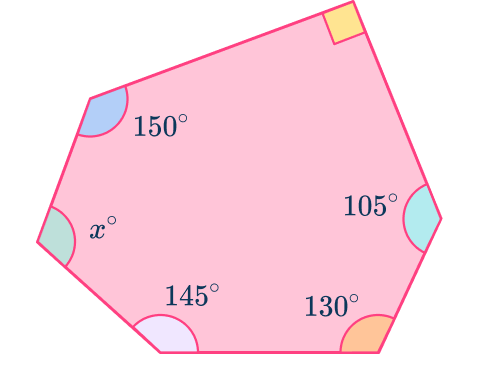
Identify the number of sides and whether any polygons are regular/irregular.
6 sides
Irregular hexagon
Find the sum of interior angles of the polygon(s) given.
Sum of Interior Angles =(n-2)\times{180}
As n=6,
Sum of Interior Angles =(6-2)\times{180}=4\times{180}=720^{\circ}
Solve the problem using the information gathered.
You need to calculate the missing angle x. Note that you know the values of all the other angles.
\begin{aligned}150+90+105+130+145+x&=720 \\\\
620+x&=720 \\\\
x&=100 \end{aligned}
The size of angle x=100^{\circ}
How to find exterior angles of polygons:
- Identify the number of sides and whether any polygons are regular/irregular.
- Identify what the question is asking and recall the sum of exterior angles.
- Use the known information and any correct formula to solve.
Example 4: finding an exterior angle
What is the size of one of the exterior angles of an equilateral triangle?

Identify the number of sides and whether any polygons are regular/irregular.
An equilateral triangle has 3 angles of equal size.
Identify what the question is asking and recall the sum of exterior angles.
The question is asking to find the size of one exterior angle of a triangle.
The sum of exterior angles for a triangle is 360^{\circ}.
Use the known information and any correct formula to solve.
As the shape is regular, each exterior angle is the same size. You can therefore divide the sum of exterior angles (360^{\circ}) by the number of slides (3) to get the size of one exterior angle.
360\div{3}=120^{\circ}
Example 5: finding an exterior angle given an interior angle for an irregular polygon
An irregular heptagon has one interior angle that is 115^{\circ}. What is the size of the adjacent exterior angle?
Identify the number of sides and whether any polygons are regular/irregular.
An irregular heptagon is a seven sided polygon.
Identify what the question is asking and recall the sum of exterior angles.
As adjacent means next to, you are being asked to find the size of the exterior angle where the interior angle on the line is known.
Use the known information and any correct formula to solve.
Angles on a straight line add to 180^{\circ} and the interior angle is 115^{\circ}.
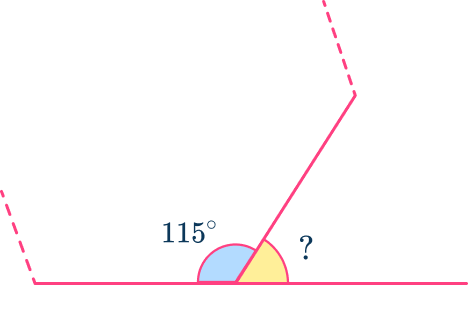
180-115=65^{\circ}
The exterior angle will be 65^{\circ}.
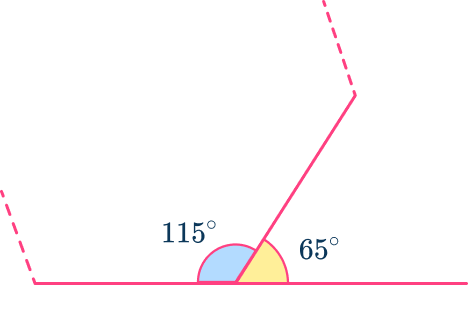
Example 6: finding the number of sides given the interior angle of a regular polygon
The size of each interior angle of a regular polygon is 140^{\circ}. How many sides does the polygon have?
Identify the number of sides and whether any polygons are regular/irregular.
The polygon has an unknown number of sides, or n sides.
It is a regular polygon, therefore all exterior angles are equal.
Identify what the question is asking and recall the sum of exterior angles.
You need to find the number of sides.
The sum of the exterior angles of a polygon is 360^{\circ} and each exterior angle is equal because it is a regular polygon.
The sum of an interior and an exterior angle is 180^{\circ}.
Use the known information and any correct formula to solve.
If the interior angle is 140^{\circ} then the exterior angle will be 180-140=40^{\circ}.
The number of sides can therefore be calculated by 360\div{40}=9.
The polygon has 9 sides.
Teaching tips for interior and exterior angles of polygons
- Create anchor charts for the classroom that show the different polygons with the interior and exterior angles labeled. Using different colors can assist students in differentiating between the two types of angles.
- Instead of using worksheets and having students label the interior and exterior angles, have students use cut outs of the different polygons and have them investigate the measures of each.
Easy mistakes to make
- Confusing interior and exterior angles
Reinforce with students that interior means “inside” and exterior means “outside”, and they come together to form a side. Using labeled diagrams can help students with differentiating the two types of angles.
- Misidentifying if a polygon is regular or irregular
Make it clear that regular polygons have equal interior and exterior angles, but irregular polygons do not. Teach students to recognize when a polygon is regular versus irregular and to adjust their calculations as needed.
- Forgetting that interior and exterior angles are supplementary
Students need to be familiar that an exterior angle and interior angle add up to 180 degrees. Reinforce with practice problems where students are given either the interior or exterior angle and asked to find the other.
Interior and exterior angles of polygons practice questions
1. Find the size of each interior angle for a regular octagon.




A regular octagon is an 8 -sided, regular shape, so you can substitute n=8 into the formula.
Sum of interior angles =(n-2)\times{180}=(8-2)\times{180}=6\times{180}=1080^{\circ}
The question is asking for ‘each interior angle’, which means the size of one interior angle.
You know the sum of the interior angles for this polygon is 1080^{\circ}. Since it is a regular polygon, all the angles are of equal size.
Each interior angle =\cfrac{1080}{8}=135^{\circ}
The size of each interior angle is 135^{\circ}.
2. Find the size of each interior angle for a regular decagon.




A regular decagon is a 10 -sided, regular shape, so you can substitute n=10 into the formula.
\begin{aligned}\text{Sum of interior angles}&=(n-2)\times{180} \\\\ &=(10-2)\times{180} \\\\ &=8\times{180} \\\\ &=1440^{\circ} \end{aligned}
The question is asking for ‘each interior angle’, which means the size of one interior angle.
You know the sum of the interior angles for this polygon is 1440^{\circ}. Since it is a regular polygon, all the angles are of equal size.
\text{Each interior angle}=\cfrac{1440}{10}=144^{\circ}
The size of each interior angle is 144^{\circ}.
3. Find the size of angle y.
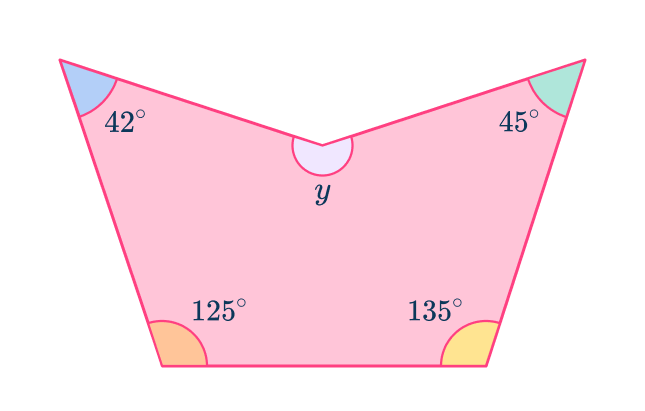




Find the sum of interior angles of the 5 -sided polygon given.
\begin{aligned}\text{Sum of interior angles}&=(n-2)\times{180} \\\\ &=(5-2)\times{180} \\\\ &=540^{\circ} \end{aligned}
\begin{aligned}42+45+125+135+y&=540 \\\\ 347+y&=540 \\\\ y&=193^{\circ} \end{aligned}
4. Find the size of one exterior angle of the regular polygon.





The polygon has 5 sides, and the sum of the exterior angles is 360^{\circ}.
Use the sum of the interior angles of a pentagon, 540^{\circ}.
\text{One interior angle}=540\div{5}=108^{\circ}

One exterior angle is equal to 180-108=72^{\circ} because the interior angle and exterior angle of a polygon lie on a straight line.
The measure of one exterior angle is 72^{\circ}.
5. An irregular hexagon has one interior angle that is 87^{\circ}. What is the size of the adjacent exterior angle?




As adjacent means next to, you are being asked to find the size of the exterior angle where the interior angle on the line is known.
Angles on a straight line add to 180^{\circ} and the interior angle is 87^{\circ}.
180-87=93^{\circ}
The exterior angle will be 93^{\circ}.
6. The size of each interior angle of a regular polygon is 120^{\circ}. How many sides does the polygon have?
8 sides

9 sides

5 sides

6 sides

The sum of the exterior angles of a polygon is 360^{\circ} and each exterior angle is equal because it is a regular polygon. The sum of an interior and an exterior angle is 180^{\circ}.
If the interior angle is 105^{\circ} then the exterior angle will be 180-120=60^{\circ}.
The number of sides can therefore be calculated by 360 \div 60=6.
The polygon has 6 sides.
Interior and exterior angles of polygons FAQs
The exterior angle theorem states that the exterior angle of a triangle is equal to the sum of the two non-adjacent interior angles. In other words, the exterior angle is equal to the sum of the two interior angles that are not directly next to it.
No, because the interior and exterior angles are supplementary (add up to 180^{\circ} ), the exterior angle cannot be larger than the interior angle.
The smallest possible interior angle of a regular polygon is 60^{\circ}, which occurs in an equilateral triangle.
The next lessons are
- Congruence and similarity
- Transformations
- Mathematical proof
- Trigonometry
Still stuck?
At Third Space Learning, we specialize in helping teachers and school leaders to provide personalized math support for more of their students through high-quality, online one-on-one math tutoring delivered by subject experts.
Each week, our tutors support thousands of students who are at risk of not meeting their grade-level expectations, and help accelerate their progress and boost their confidence.

Find out how we can help your students achieve success with our math tutoring programs.
[FREE] Common Core Practice Tests (3rd to 8th Grade)
Prepare for math tests in your state with these 3rd Grade to 8th Grade practice assessments for Common Core and state equivalents.
Get your 6 multiple choice practice tests with detailed answers to support test prep, created by US math teachers for US math teachers!